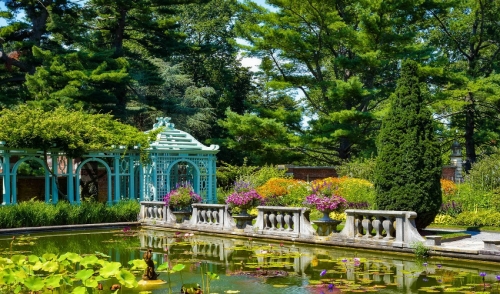{article.name} Monthly Blog Articles
WE DELIVER
Peterborough, NH: 603-924-6801 Brattleboro, VT: 802-254-8755 Walpole, NH: 603-756-9400 Hillsboro, NH: 603-464-3755 Milford, NH: 603-673-1669 Keene, NH: 603-357-5720Gardening in Challenging Spaces

- Share this:
- Share on Facebook
- Pin on Pinterest
- Tweet on Twitter
Every garden is different, and very few gardeners are fortunate enough to have a perfect plot of level, rich soil with exactly the right amount of sunlight, moisture and drainage for every gardening dream. No matter how challenging your gardening space may be, however, there are always ways to overcome those challenges and make the most of every inch of your garden.
Overcoming Common Gardening Challenges
There are many different challenges that can occur in any garden space, but there are always options to confront those challenges. The most common challenging spaces gardeners face, and how to successfully meet those challenges, include…
- Clay Soil
Thick, compact clay soil can be difficult for roots to penetrate, leading to poor growth for both landscaping and garden plants. This soil can also be too wet, leading to root rot. Adding organic material to the soil can help improve its condition and drainage. Planting a cover crop in the off season is also a good idea, as the roots of that crop will decay and help improve the area where it was planted. Raised garden beds can also do well on top of clay soil for easier gardening.
- Sandy Soil
The opposite challenge of clay soil is sandy soil that has too much drainage and will not hold enough nutrients to thoroughly nourish plants. Amending this loose soil with abundant compost and manure will help improve it and add more nutrition for plants to take advantage of. Ideally, layer compost and manure in the fall so it can decay and enrich the soil over the winter months.
- Not Enough Sunlight
The best gardens get abundant sunlight, but even a shady area can be a good gardening spot if you know how to overcome this challenge. Pruning nearby trees and shrubs can permit more sunlight to reach the garden, or paint a nearby fence or wall a light color to reflect more sunlight into the garden. Shade-loving plants such as many flower types, leafy greens, and vegetables such as carrots, broccoli, kale, peas and potatoes can also do well in a shadier garden.
- Small Spaces
Whether it is a narrow side yard, a tiny corner or a petite terrace, a small space doesn't mean there isn't enough room for a garden. Adding containers can increase the available gardening space, or you can install a trellis or arbor to encourage climbing vines and vertical gardening space. Hanging pots can also be used to increase gardening space, and don't be afraid to layer crops or crowd plants a bit more tightly to maximize the size of the garden.
- Poor Drainage
Most garden plants don't like wet roots, and a too-damp, bog-like section of a garden can be a poor producer. Improving drainage by elevating planting rows can help a garden thrive, and be sure there are no unwanted sources of water nearby, such as a downspout that could be redirected away from the garden. Consider water-loving plantings such as corn, lettuce, cabbage or rain garden plants to take advantage of a naturally wet area.
- Steep Terrain
A very steep yard can be a tough gardening challenge, but you can easily overcome it when you add terraces throughout the space. This will provide smaller level spaces for gardening that can be used as raised beds or container gardens, maximizing gardening space even on a steep slope. Extra containers can also be added for even more space, or you can opt for vines and climbing plants that will enjoy the steepness.
- Few Pollinators
The most luxurious garden will be thriving with pollinators that will increase the harvest and encourage more flower blooms. If the community routinely sprays for pests, however, there may not be enough pollinators for a productive garden. Adding a bee house or putting up a hummingbird feeder can attract more pollinators, or choose self-pollinating plants such as peas, peppers, tomatoes and sunflowers.
- Too Many Pests
While pollinators may be welcome in the garden, other pests such as fungus, molds, aphids, snails, beetles and cutworms aren't as welcome when they chew on foliage, damage vegetables and otherwise harm plants. Identify the pests properly in order to treat them effectively, and use clean tools in the garden to avoid spreading any contamination to other plants.
When More Challenges Arise
In addition to the most common garden challenges and difficult spaces for growing, each garden is different and new challenges can always arise throughout the season. Trying different techniques is essential to learn what will work best in your garden, and many gardeners learn a great deal through trial and error. If you come across a challenge you just can't seem to overcome, however, visit your local garden center for expert assistance. Bringing along photos or samples of leaves or plants that are struggling can help the staff properly diagnose your problem and help you find the perfect solution to overcome any challenge your garden presents.



Comments